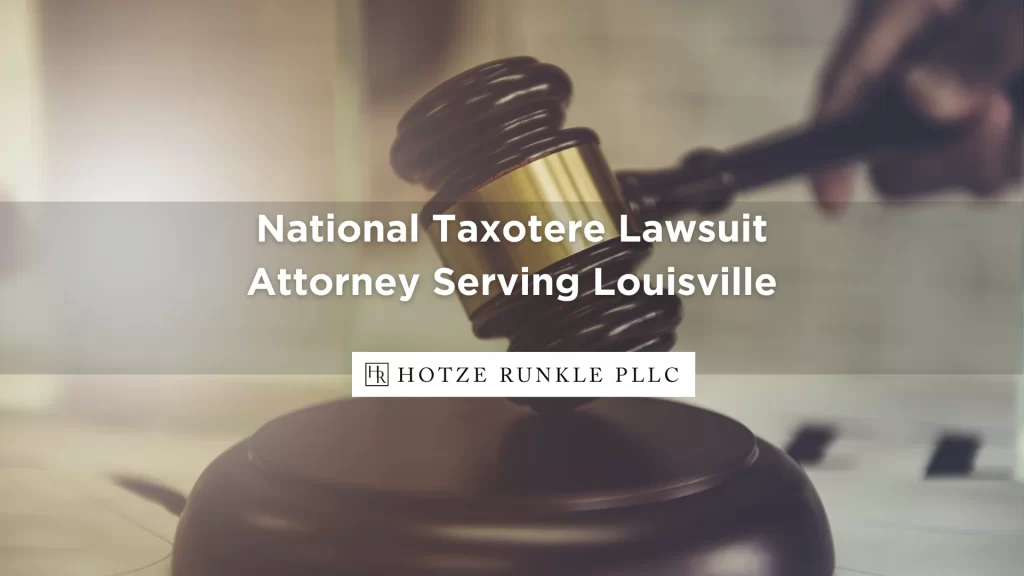
Have you noticed your eyes have been watering excessively since treating your cancer with Taxotere? Have other unexpected symptoms also developed that your doctor never warned you about? If so, contact Hotze Runkle PLLC, and we might be able to help you pursue compensation from the drug manufacturer.
Sanofi-Aventis developed the chemotherapy drug Taxotere to treat different types of cancer, such as prostate cancer, neck cancer, breast cancer, and head cancer, to name just a few examples. It works by shrinking cancer cells and preventing them from spreading to other body parts. Unfortunately, medical researchers found a dangerous link between a patient’s tears and secretions from the drug.
Cancer survivors and their families have filed lawsuits against Sanofi for their inadequate warning of the risks associated with their drug.
Common Symptoms Experienced During Taxotere Chemotherapy
Chemotherapy can lead to a range of unpleasant side effects. Taxotere has been known to cause epiphora, which is uncontrollable and excessive eye-watering. You might have brushed off this symptom as a normal side effect of your chemo treatment. However, it can progress and lead to other problems, including a permanent medical condition.
Canaliculi are structures in the ocular cavity responsible for funneling tears from the tear ducts and into the nasal cavity. We all have four: one in each eyelid. When the canaliculus becomes inflamed, tears are unable to travel through it correctly. Instead, tears will build up on the eye’s surface, resulting in eye-watering. Chronic inflammation can cause the canaliculus to close permanently.
As the condition worsens, Canalicular Stenosis can develop and cause debilitating symptoms, such as:
- Central vision loss
- Headaches
- Eye infections
- Sensitivity to light
- Swollen eyelids
- Dry eyes
- Blurry or clouded vision
It’s critical that you notify your oncologist of the adverse reaction you’re having from Taxotere so they can find an alternative chemo drug to use during your cancer treatment. You should also undergo a medical examination by an ophthalmologist to discuss possible treatment options to manage your Canalicular Stenosis symptoms.
The Adverse Reaction That Causes Canalicular Stenosis
Your chemo regimen with Taxotere will depend on the type of cancer you have and how severe the diagnosis is. Some people only need the drug every three weeks, while others require it once a week. No matter how often you receive your treatment, Taxotere could interact negatively with your tears, resulting in Canalicular Stenosis.
While performing various studies, medical researchers noticed an unusual reaction between secretions from the chemotherapy drug and a person’s tears at the drug travels through the canaliculus. Direct contact between the drug and tears can cause chronic inflammation. Without immediate medical intervention, infections could form and create obstructions, blocking the tears from funneling into the nasal cavity.
Over time, the obstructions can get worse, causing the canaliculus to close. Whether it closes partially or entirely, there’s no way to reverse the effects. A surgeon could possibly perform a procedure to manage your symptoms, but there’s no known cure for this medical condition.
Options You Might Qualify for If You Have Canalicular Stenosis
You could potentially alleviate your symptoms by undergoing a surgical procedure. Dacryocystorhinostomy (DCR) requires a doctor to cut an incision between your eye and nose and use the structures beneath to create a new passageway for your tears. Under certain circumstances, they might place a stent to facilitate the flow of tears around the obstructed canaliculus so they don’t build up on the eyeball.
Unfortunately, some cases are so severe that the surgeon can’t form a new passageway with structures around the damaged canaliculus. Instead, they might have to perform conjunctivacryocystorhinostomy (CDCR). During CDCR, they can use a Jones tube, a tiny glass tube, and place it over the obstructed canaliculus so tears can funnel into the nasal cavity as intended.
DCR and CDCR are risky surgeries. They can effectively manage symptoms and prevent Canalicular Stenosis from worsening; however, there are some risks involved. Common side effects include:
- Migrating Jones tube or stent
- Eye infections
- Damage to tissues and eye structures
- Sinusitis
- Blindness
- Permanent facial scars
- Uncontrollable bleeding during and after surgery
- Ineffective procedure
You could explore your treatment options by discussing your condition with an ophthalmologist. Depending on your overall health and certain risk factors, they can determine if either choice is right for you. You can continue your chemotherapy regimen but inform your oncologist of the symptoms you’ve been experiencing so they can switch the drug they’re administering.
Possible Compensation Available in a Lawsuit Against Sanofi
 You likely suffered multiple losses from your diagnosis of Canalicular Stenosis. You not only sustained physical injuries but emotional trauma as well. Your symptoms resulted in medical bills that you shouldn’t have to pay. The drug company should be held liable for their negligent actions and provide the necessary compensation to cover your past and future losses.
You likely suffered multiple losses from your diagnosis of Canalicular Stenosis. You not only sustained physical injuries but emotional trauma as well. Your symptoms resulted in medical bills that you shouldn’t have to pay. The drug company should be held liable for their negligent actions and provide the necessary compensation to cover your past and future losses.
These losses could include:
- Pain and suffering
- Medical bills
- Loss of enjoyment of life
- Mental anguish
- Lost wages
- Lost earning capacity
- Loss of consortium (sought by a spouse for the effects of the injury on their relationship with you)
You might also be entitled to punitive damages. This is not a financial award intended to compensate you for your physical, economic, and emotional losses. Instead, it punishes the at-fault party for their misconduct and deters similar wrongdoings in the future. A jury will only award you with punitive damages if you can provide clear and convincing evidence that Sanofi acted with fraud, malice, or oppression.
Kentucky follows a strict one-year statute of limitations. This is the timeframe for filing a lawsuit for compensation for your losses. You must sue the drug manufacturer within one year from the date of your injury, or you could lose your right to seek compensation.
Find Out If You’re Eligible for A Lawsuit
Hotze Runkle PLLC has been representing injured victims since 2007. We have recovered over $100 million for our clients in insurance claims and jury verdicts. You deserve the opportunity to hold Sanofi-Aventis accountable for the suffering you were forced to endure from their dangerous drug.
If you developed Canalicular Stenosis or noticed an adverse reaction from your Taxotere treatment, take our Evaluation Quiz to determine if you can file a lawsuit for compensation.